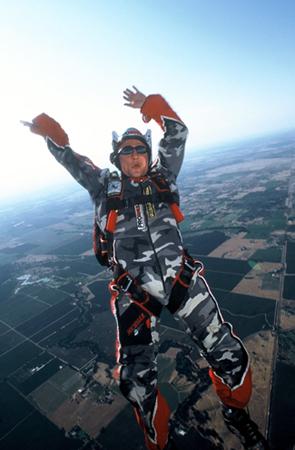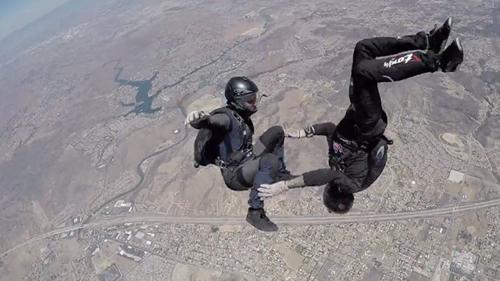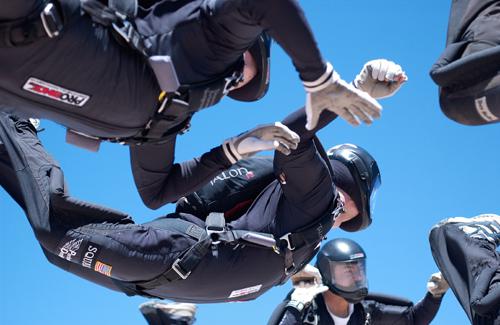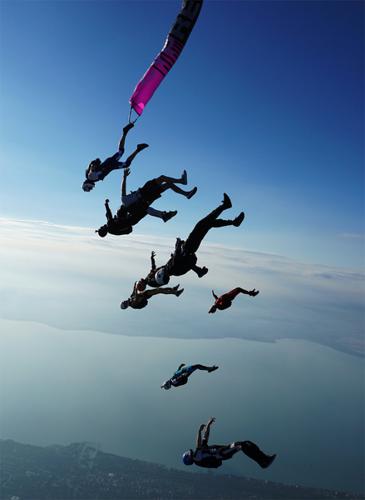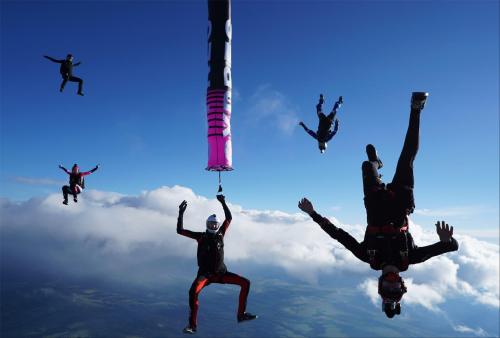For BASE jumping information, BASE jumping articles, photos, videos and discussions visit BASEjumper.com
This article was written entirely by Tom Aiello, BASE 579. Tom has made more than 500 BASE jumps in the past 3 years, from over 100 objects. He is not an authority or expert of any kind on BASE jumping or any other type of parachuting, so all his advice should be taken with a grain of salt. All opinions are those of the author only. By making any fixed object parachute jump, you are taking your life in your own hands, and accepting responsibility for any possible outcome. Copyright 2002. Permission to reproduce and distribute in this exact form only is hereby granted.
So, the time has come to buy your first BASE rig. You've made the skydives, practiced your canopy control, and have an experienced mentor to keep you out of trouble. But what rig should you buy? If you have less than 30 jumps, here are my recommendations (more jumps than that, and you're on your own).
The really critical thing is to buy purpose-built BASE gear. Lots of people have been BASE jumping with converted skydiving gear for a long time. It is time for this to stop. Skydiving gear is very dangerous for BASE jumping, and has caused, and continues to cause, fatalities, especially among beginners, in the BASE world. Please don't become a statistic.
The guiding principle for selecting a first BASE rig is "Keep it Simple." If you are faced with a choice between a simpler and a more complex option, always choose the simpler one.
In this article, I will focus on stock (non-custom) gear from major manufacturers, which is what the majority of first BASE gear purchasers must choose from. Note that I will pick and choose from various manufacturers. If you want to take advantage of the "package" prices offered by most manufacturers, you will not have this option. If you are doing this, I strongly recommend selecting your canopy first, and letting that choice determine your package. In the end, it is the canopy that will make or break your system. The container is, in the words of one BASE jumper, "just the garage you park your Ferrari in."
Canopy
Not Optional: Tailgate
It is absolutely mandatory that any BASE canopy deployed with the slider removed or tied down use a tailgate. The tailgate is reefing device developed by Basic Research to promote nose first inflation, and reduce the incidence of line over malfunctions. Under no circumstances should a beginner jump a canopy without a tailgate.
Option: Secondary Inlets
Several BASE canopies (FOX Vtec, Flick Vtec, Blackjack, Troll) are now available with secondary (bottom skin) inlets. These additional inlets provide faster inflation, give rear riser response earlier in the inflation sequence, and can help keep the canopy inflated in some emergency situations (such as an object strike pinching off the nose). They slightly increase pack volume, especially on the canopies (Troll, Blackjack) where they are covered with one way valves to retain the canopies original flight characteristics. They may also create some poorly understood, but relatively undesirable phenomenon, such as opening backsurge in deep brakes. There is no real consensus in the BASE world on the suitability of secondary inlets for beginners.
I believe that beginners should avoid canopies with bottom skin inlets. There are several reasons for this. First, no beginner should jump a system that has poorly understood effects of any kind. Second, a beginner should not be jumping objects in which the advantages of secondary inlets are critical (for example, opening very near to an object). Third, secondary inlets add expense to the canopy (especially the one-way valve systems, which are generally superior to the open vents). My recommendation is to avoid bottom skin inlets until you know enough to want them for your particular (advanced) jumping style.
Option: Multi Bridle Attachment
The multiple bridle attachment is available on FOX canopies from Basic Research. Essentially, the multi replaces the standard, single bridle attachment point with a line cascading to four separate attachment points (one in the standard location, one near the rear of the center cell, and one each on cells three and five). The objective is to reduce center cell stripping (the center cell pulling out of the free packed canopy on deployment), and thereby improve opening heading and consistency. While the theory is sound, I am not convinced of the practical benefits, especially at subterminal airspeeds. Given that, I would not recommend the system for a beginner, as it adds both complexity and price (US$150) to the parachute system.
Option: ZP/Composite Topskin
Most BASE manufacturers offer topskins made either wholly or partly of zero porosity material. There are several advantages to this configuration, including better flight performance, stronger flare, and faster openings. Unfortunately, there is one big disadvantage-packing. When you are learning to pack for BASE, there are enough difficulties and distractions without throwing in another one. I'd recommend that a beginner get an all F-111 canopy, for simplicity and ease of packing, which translates into better opening heading.
Recommendation: Ace, all F-111, Consolidated Rigging
My favorite all around BASE canopy is the Ace, from Consolidated Rigging. The Ace airfoil (which is identical to the Blackjack) has tremendous control range, giving both very high and very low speeds. It flares quite well, although you may have to adjust toggle settings for your personal arm length and preference. It also opens (the real issue in BASE canopies) faster, cleaner, and more consistently than any other unvented canopy on the market. In my opinion, the best canopy for a beginning BASE jumper is a standard, all F-111 Ace.
Avoid: Any Skydiving Canopy, Unvented Troll
Do not jump any skydiving canopy (PD 7 Cell, Raven, PD Reserve, etc) in the BASE environment. This is an archaic practice that should be stopped. With real, purpose built BASE canopies available, there is virtually no reason to ever leave a fixed object with a skydiving canopy on your back (and the few reasons that do exist-salt water landings, gear confiscation-are pretty much inapplicable to a beginner). Don't kill yourself trying to save a few dollars. Buy real BASE gear.
I personally have had very bad openings on my Troll (Atair Aerodynamics). My openings have been wildly inconsistent, and included unacceptable snivels, end cell closures, and asymmetric inflation (leading to off-heading openings). As a relatively experienced jumper, using every technique I can think of, including those recommended by the manufacturer, I have been unable to achieve consistently good openings in my jumps (just under 100) on this canopy. Although the Troll's flight characteristics are fantastic, the openings make this canopy unacceptable for a beginner.
Container
Velcro or Pin?
The first thing you have to decide is if you want a Velcro or pin closed container. For a first container, get Velcro. Velcro rigs are simpler, cleaner, and easier to pack and use. Pin rigs are advanced gear, because you must have your pack job dialed in to achieve the correct pin tension, because many acquire adjustment for various altitudes, and because it's harder to close a pin rig without disrupting your pack job. The only case in which you should consider a pin rig for your first rig is if you are an experienced wingsuit pilot determined to jump right into wingsuit BASE. Velcro rigs are unsuitable (and very dangerous) for wingsuit flights. However, Velcro rigs are well proven for delays from 0-15 seconds, so any non-wingsuit jumper should definitely start with a Velcro closed BASE rig, regardless of their intended objects and delays.
Option: Alpine
Basic Research offers a built in climbing harness as an option on their BASE rigs. I have owned a rig with this option for some time, and have found that I rarely use it. For the extra cost and complexity (the extra buckles have some small potential to confuse the uninitiated), I'd definitely skip this option.
Option: Saddle Bags
Saddle bags are built in "pockets" sewn onto the leg straps of the rig's harness. These can be handy for stashing bits of rescue, first aid, or climbing gear, or just as a place to put your camera after shooting exit shots of your friends. I also have this option on one of my rigs, and while I do use it, I haven't found it indispensable enough to recommend it. For a first rig, avoid the saddle bags.
Option: B-12's
B-12's are the snap closures on old-style skydiving leg straps. They can be extremely useful on some relatively advanced jumps (those where room to gear up is limited). However, the use of B-12's with a hand held pilot chute (which is the proper beginner deployment technique) has caused at least one BASE fatality. If you do use B-12's on your BASE rig, be sure that you always snap your leg straps before removing your pilot chute from the bottom of container (BOC) pouch. In the interests of simplicity, this is another option I'd leave off a first BASE rig.
Option: Stainless Steel Hardware
Following the popularity of stainless hardware in the skydiving world, most BASE gear manufacturers now offer rigs with stainless hardware, both in the harness geometry and the three ring system. Unless you know that you will be making a large number of water landings, there is very little reason to add the expense of stainless hardware to your rig.
Option: Sorcerer
The Sorcerer is a two parachute BASE container manufactured by Vertigo BASE outfitters of Moab, Utah. Although some skydivers will like the extra confidence of a second canopy, the truth is that the Sorcerer is really an advanced trick rig. Advancing technology has made BASE gear so reliable (statistically more reliable than skydiving reserves), that adding a second canopy really gives very little additional insurance. In addition, the two canopy system is a poor choice for beginners because (a) it makes them less likely to pay the proper level of attention (meticulous) to their pack job, (b) it may make them overconfident, even in situations where the Sorcerer's second canopy (which deploys admirably quickly, in less than 150' under ideal conditions) will have insufficient altitude to inflate, (c) the system is more complex, and a beginner should use the simplest system possible, (d) it is cumbersome to carry around a second canopy you never use, and (e) The extra bulk of large canopies tends to make most Sorcerer jumpers use canopies that are significantly undersized for BASE landing areas, which could be a very costly and injurious problem for a beginner. Note that some skydivers may feel that having a "reserve" is worth the cost. However, the second canopy on a Sorcerer is no more a "reserve" than the first. Any BASE system, properly assembled, maintained, and packed, will open more reliably and consistently than any skydiving reserve system. Jumping a Sorcerer isn't like having a reserve-it's like having two reserves. Save the Sorcerer for advanced trick jumps (like BASE fun-aways), when you are more experienced. For now, stick with a standard BASE system.
Option: Para-pack
The Para-pack is specialized BASE rig that allows you to stow gear (camping gear for long approaches, for example) between the back pad and the pack tray. The rig is remarkably clean, and maintains tension over the pack tray quite well. However, unless you have a specific need for this type of expedition jumping, there is no need to spend the extra money (it's something like US$500) and deal with the extra complexity of the system.
Option: Hook Knife
Originally, a hook knife was considered mandatory equipment for BASE. However, as gear technology advanced, and it became clear that the incidence of slider up line over malfunctions was extremely low, hook knives started to be left off of BASE rigs. However, there have been at least three documented cases of slider up line overs in the past two years, and one of them required the use of a hook knife to clear. Even if this happens on only one in 1000 jumps, it is worth carrying a hook knife for the other 999. Since the cost of a hook knife is quite low, and there is no inconvenience in carrying one, you should purchase a hook knife with your first BASE rig.
Recommendation: Vision, Gravity Sports Limited
My personal favorite Velcro rig is the Vision, from Gravity Sports Limited. The Vision was designed, built, re-designed, and re-built by Dennis McGlynn while he was jumping very aggressively. Everything about this rig screams "ease of use." It is incredibly simple, it is very comfortable, and it absolutely minimizes distortion of your pack job, both on the way into, and on the way out of, the pack tray.
Secondary Recommendation (Pin): Gargoyle, Morpheus Technologies
If, and only if, you are an experienced wingsuit pilot intending to take your wingsuit to the cliffs as soon as possible, you should skip a Velcro rig (very dangerous for wingsuit jumps due to the potential for a premature deployment) and go straight to a pin rig. It would be far better to buy a Velcro rig and become an expert BASE jumper before launching your wingsuit. However, if you are dead set on moving straight to wingsuit flights (which I do not recommend), you will need a pin rig. My favorite pin rig is the Gargoyle, by Morpheus Technologies. If you are jumping a wingsuit, you will definitely want the dynamic (open) corners option. The Gargoyle has superb pin protection (better than any other two pin rig), does an excellent job of maintaining pack symmetry both into and out of the pack tray (it is probably the best of the pin rigs in this critical area), and can be closed exactly the same at any altitude (reducing complexities that could be troublesome early in your BASE career).
Avoid: "Home Made"Rigs
Many jumpers (including myself) begin their BASE careers using "home-" or "rigger-made" BASE gear. Unfortunately, many of the minor manufacturers who produce these rigs are so far out of the main stream that they make rigs with design flaws (minor or major) that have long since been worked through and eliminated from the rigs built by major manufacturers. Avoid purchasing a rig from a friend, or your DZ rigger, and instead purchase your gear from a major manufacturer. In general, if you cannot buy a real, purpose built, BASE canopy (Ace, Blackjack, Mojo, FOX, Flick, Dagger or Troll) with your rig, from the same shop, you should look to purchase the container elsewhere.
Avoid: Unstiffened Side Velcro
Some older Velcro rigs have unstiffened side flap Velcro. Examples include early Odysseys and Reactor 3's. Unstiffened side flap Velcro can shrivel with the shrivel flap during a head down deployment, and should be retrofitted with a stiffener to prevent a pilot chute in tow malfunction. All major manufacturers have rectified this design flaw, and will retrofit older rigs to eliminate the problem.
Pilot Chutes
Eventually, every BASE jumper accumulates a large collection of pilot chutes for various delays. As a beginner, you will need to acquire at least three. To paraphrase my BASE mentor, you will need one PC each for terminal jumps, really low jumps, and everything else. In general, that means one 32-36" PC (terminal), one 46-50" ZP PC (low) and one 42" ZP PC (everything else). Unless you live in Norway or Australia, you will quickly find that the 42" ZP is your workhorse PC, and that you leave it on your rig for everything from 2-6 second delays. Later on, you will want to fine tune your PC's for your delays. For example, one manufacturer recommends a set of four PC's (32", 38", 42", and 46") to cover all possible delays. When you are starting, though, you can save money (and simplify your systems) by going with just three-little for terminal, big for go and throws, and 42" for everything else. Just about everyone uses ZP material exclusively for BASE PC's. In some cases, F-111 can have advantages over ZP, but all your subterminal PC's ought to be ZP in the beginning.
Option: Bridle Attachment Point
There are several different configurations possible for bridle attachment on a pilot chute. The standard configuration used by virtually every BASE gear manufacturer (CR, BR, Morpheus) allows the jumper to asymmetrically attach the PC to the bridle. The older style of attachment (Paratech Rigging) is far superior, as it makes an asymmetric attachment (which greatly contributes to orbiting, and hence degrades heading performance on opening) virtually impossible. If at all possible, order your PC's with the older "loop" style attachment point.
Option: Apex Vents
Some manufacturers are now offering pilot chutes with mesh vents at the apex. The purpose of these vents is to dampen the oscillation inherent in a pulled down apex round (like a pilot chute), as well as reducing the orbiting that often results from a vigorous PC toss. This is one of the few options that I would strongly recommend for any jumper, even a beginner. The vents really don't create any added complexity packing, and really do help improve opening heading (which suffers dramatically from oscillating and orbiting pilot chutes). Vented pilot chutes are not recommended for low freefalls with very short (less than one second) delays, as they do inflate slightly slower than unvented PC's.
Recommendation: Apex Vented 42", Consolidated Rigging
My favorite 42" PC is the A-V pilot chute from Consolidated Rigging. The CR A-V series, in addition to the apex vent, has a slightly oversized topskin, which contributes to stability.
Recommendation: 36" F-111, Basic Research
For terminal delays (without a wingsuit-wingsuit PC's should be slightly larger), the standard BASE PC is either a 32" ZP, or a 36" F-111 PC. For a beginner, I would recommend a 36" F-111 PC, as F-111 PC's appear to be more stable than ZP (even vented) PC's, and the advantages of ZP (faster inflation) should not matter to a beginner at terminal (no beginner should pull low enough that the PC inflation time difference becomes important).
Recommendation: 48" ZP, Basic Research
For low, hand held deployments, I prefer the Basic Research 48" ZP PC. BR does not put a handle of any kind on their 48", which is mandatory for hand held deployment. Further, they do not put any kind of cap or vent on the PC, either of which could slow inflation, and cost critical feet at low altitudes.
Avoid: The Hook, Gravity Sports Limited
Gravity Sports pilot chutes have the load tapes applied on the block, rather than the bias of the ZP material. This allows the pilot chute to stretch and deform, both over time with wear, and instantaneously during each deployment. This can result in asymmetries and oscillation, both of which can degrade opening heading.
Risers
Although almost all BASE specific risers meet certain criteria (type VIII, LRT style toggles, etc), and you should be fine sticking with whatever riser and toggle system comes standard with your first rig, it is slightly better to purchase toggles and risers separately, to allow a wider choice in available options. If cost is a primary consideration, just go with the standard setup. But if you have a bit more money to spend, consider ordering exactly the riser setup you want.
Not an Option: Mini-Risers (Type 17)
Occasionally, skydivers (and one German BASE manufacturer) will attempt to use mini-risers on a BASE rig. This is totally unacceptable. Mini risers have failed in actual use, and if that were to happen on a BASE jump (more likely than on a skydive, as BASE openings are harder), you would be lucky to survive. Under no circumstances should a beginner (or any other BASE jumper) use equipment with mini-risers.
Option: Pin v. Cloth Toggle Stubs
BASE toggles are available with either standard (stiffened cloth) or metal pin toggle stubs. The standard stubs are generally preferred. Although the metal pins have virtually no chance of toggle hang-up, the incidence of hang-ups on the cloth stubs (with the thick Dacron lines used for BASE canopies) is near zero. Also, the metal pins tend to wear the brake settings more quickly, and are slightly more likely to prematurely release ("blow" a toggle) during the opening sequence.
Option: Mini Rings (RW8)
Most BASE gear manufacturers offer mini three rings, either as an option, or standard equipment. Since the manufacturing tolerances for these rings are tighter, and there is no disadvantage in using standard large (RW1) rings, avoid mini-rings on your first BASE rig. If possible, you might wish to use large tandem strength (RW10) rings, which are available from some manufacturers.
Option: Big Grab Toggles
Several manufacturers now offer stiffened toggles. These go by a variety of names, including "Big Grab" and "EZ Grab". Although the best way to avoid object strike is to correct heading on risers, there are some situations in which a BASE jumper wishes to release the toggles immediately, with no hesitation and no fumbling. Stiffened toggles are designed to make this much easier, and generally work in that regard. They do make packing marginally more difficult, and for that reason, should be avoided by a beginner. However, like line release toggles, this is a piece of equipment you should consider adding quite early in your BASE career. If cost is a major issue (you don't want to spend the extra money on a second set of toggles), it is possible, but not recommended to start with big grab toggles.
Option: Integrity Three Rings
BASE risers are now available in both standard three ring and reversed (integrity) configurations. Most BASE jumpers consider the reversed (integrity) three ring to be standard equipment for BASE. Integrity risers are marginally stronger than standard risers, but are also a bit more difficult to manufacture properly. Since a standard type VIII riser has never failed in actual use, either riser set up should be fine for a beginner. The standard set-up (with a grommet through the riser) is probably more familiar to a beginner, and is definitely more field tested (there have been two reported incidences of unintentional riser release on BASE jumps-although the cause is undetermined in both instances, both releases occurred on integrity style risers). On balance, the standard three rings are probably a slightly better option for a beginner.
Option: Line Release Toggles
Several BASE manufacturers now offer toggles that can release the control line, allowing a jumper to clear a line over malfunction without resorting to a hook knife. These line release toggles are the best currently available line over clearance technology. However, the extremely low occurrence of line over malfunctions in the BASE environment, combined with the added complexity of the line release toggles, indicate that beginners should avoid their use. Although they may become standard equipment for BASE, they are not yet sufficiently proven to recommend their use to a beginner. As an aside, in the event that you do choose to purchase line release toggles with your system, I would strongly recommend a toggle with a one handed operation (such as Vertigo BASE Outfitters' WLO [What Line Over?]), rather than a toggle with a two handed operation (such as the Gravity Sports Supertoggle. All things considered, though, a beginner should avoid adding this extra complexity to their system until they are comfortable with their basic equipment.
Recommendation: Standard Three Rings, Standard Toggle, Morpheus Technologies
My favorite standard riser is the one manufactured by Morpheus Technologies. Essentially the same as the risers made by BR or CR, Morpheus' standard riser is a non-integrity three ring, with the LRT toggle system, and RW10 (tandem) three rings.
Stash Bag
Option: Waist Band
Some manufacturers (Vertigo BASE Outfitters, Gravity Sports Ltd) offer stash bags with waist bands, either permanent or removable. For technically difficult approaches, or just for longish hikes, these waist bands are an absolute life saver. Since they are generally removable, and add negligible bulk, they are highly recommended for all jumpers.
Option: Waterproof Material
Some manufacturers offer stash bags made of waterproof material. Whether you decide to use one will depend on your jumping environment. If you live somewhere that it rains often, you will find the water protection well worth the investment. However, if you live in a dry area, or frequently need to wad up and pocket your bag quickly, you may find that the extra bulk of the waterproof fabric makes it more trouble (and cost) than it is worth. I know that my waterproof stash bag (Gravity Sports, Ltd) more than paid for itself the first time I had to swim across a creek to reach the trail and hike back to the car (my rig stayed completely dry on my back).
Option: Cliff Pack
You may want to consider adding a heavier cliff pack to your gear collection. A cliff pack is a backpack, sized to fit your rig, protective gear and a bit more, with a decent suspension for hiking, and which can be collapsed into a waist pack for jumping. Although most modern jumps do not require this gear, there are certain areas with long hikes (Norway comes immediately to mind) where a cliff pack will significantly improve your hiking experience. Although you probably won't need one initially, if you are planning a trip to a site with long hiking approaches, definitely consider purchasing a cliff pack.
Recommendation: Heavy Duty Stash bag, Gravity Sports Limited
My favorite stash bag is Gravity Sports' heavy duty stash bag. This bag is burly, will take tons of abuse, has no plastic buckles (which can break at inopportune moments), and compresses moderately well. If you have a chance to pick one of these bags up, grab it.
Avoid: Stash bag, Paratech Rigging
I had very bad luck with my Paratech stash bag. The fabric was too light, and the bag survived very few jumps. In addition, the cord lock that closed the bag kept sliding open, so I had to stop every few hundred yards to verify that my gear was still in the bag.
NOTE:
My recommendations have evolved considerably during the course of this writing. Although the basic equipment I recommend for a beginner (Ace in a Vision) is the same, my views have changed as to several options (Big Grab Toggles, WLO toggles, Integrity Risers) for this writing.
Resources
BASE Gear Manufacturers
Consolidated Rigging
4035 Grass Valley Highway
Auburn, California 95602
530 823-7969
530 823-7971 fax
[email protected]
http://www.crmojo.com
Basic Research
236 East 3rd Street, Unit C
Perris, California 92570
909 940-1324
909 940-1326 fax
[email protected]
http://www.basicresearch.com
Morpheus Technologies
5107 Lantana Street
Zephyrhills, Florida 33541
813 780-8961
813 788-7072 fax
[email protected]
http://www.BASErigs.com
Vertigo BASE Outfitters
P.O. Box 1304
Moab, Utah 84532
435 259-1085
[email protected]
http://www.vertigobase.com
Gravity Sports Limited
10472 Iris Road
Truckee, CA 96161
530 582-4747
530 582-4345 fax
[email protected]
http://www.gravitysportsltd.com/dennis/
Leading Edge BASE
1425 Century, Suite 100
Carollton, Texas 75006
972 245-5300
972 245-0598 fax
[email protected]
http://www.leadingedgebase.com
Paratech Rigging
6416 Cardinal Road
Vernon, British Columbia
Canada V1H 1W3
250 260-8053
[email protected]
Used BASE Gear Classifieds On Line
http://www.blincmagazine.com/cgi-bin/forum/dcboard.cgi?az=list&forum;=classified&conf;=blinc
http://www.dropzone.com/cgi-bin/classifieds/page.cgi?g=BASE_Gear%2Findex.html&d;=1
BASE Gear Reviews
http://www.blincmagazine.com/reviews/Gear/
© Copyright 2002 Tom Aiello. Permission to reproduce and distribute in this exact form only is hereby granted. Please address any questions, comments or corrections to the author at [email protected].

